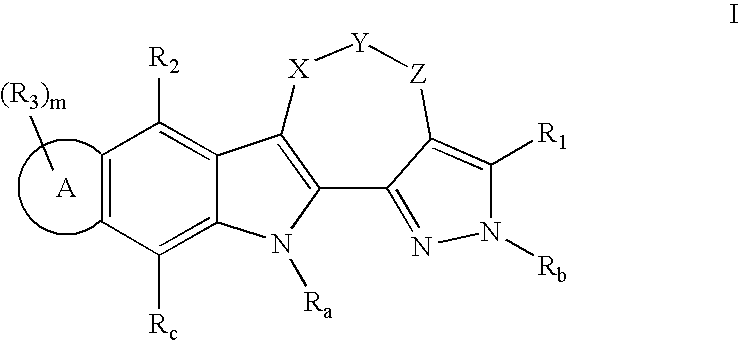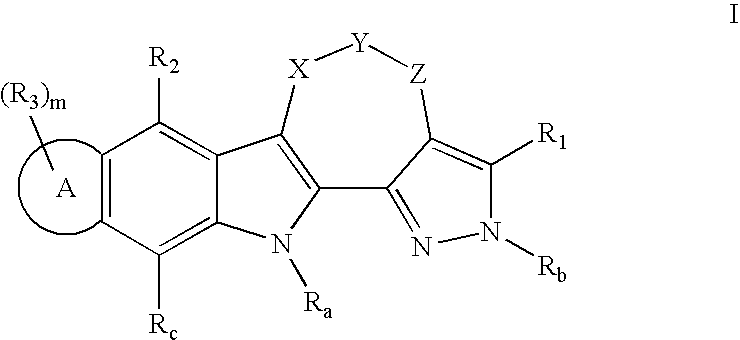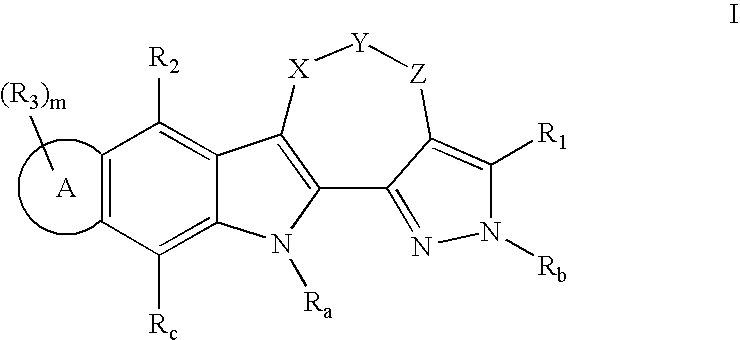Pentacyclic kinase inhibitors
a pentacyclic kinase and inhibitor technology, applied in the field of organic compounds, can solve the problems of slow tumour growth in a wide range of cancers, and achieve the effect of inhibiting the signalling of aurora kinases
- Summary
- Abstract
- Description
- Claims
- Application Information
AI Technical Summary
Benefits of technology
Problems solved by technology
Method used
Image
Examples
example 1
5-amino-1-ethyl-3,3-dimethylindolin-2-one
[0092]
[0093] Compound a (38.4 g), prepared according to the procedures described in Robertson et. al. (J. Med. Chem. 29(10) 1832-1840 (1986)), was dissolved in 300 ml of conc. sulfuric acid using mechanical stirring and cooled using a −40° C. bath until the reaction became very thick. A solution of 10.1 ml of fuming nitric acid and 50 ml of conc. sulfuric acid was added dropwiseover 30 min. The reaction was allowed to warm to ambient temperature with stirring for 12 hours. The reaction mixture was poured into ice water and compound b was collected by filtration and dried (yield: 31 g).
[0094] Compound b (9.38 g) was dissolved in 100 ml of DMF and added dropwise to a stirred suspension of sodium hydride (2 g) in 25 ml of DMF. When hydrogen evolution ceased, 4 ml of ethyl iodide was added and the reaction mixture stirred until reaction was complete by tlc. The reaction was partitioned between ethyl acetate and water. The organic extract was co...
example 2
Synthesis of Compound 32
[0096]
[0097] Compound f (2-(hydroxymethylene)cycloheptanone) was prepared by the following procedure. To a cold (0° C.) solution of 20 ml of cycloheptanone and 50 ml of dry THF was added 190 ml of lithium bis-trimethylsilyl amide solution (1M in THF) over 5 minutes. Ethyl formate (13.8 g) was then added dropwise over 15 minutes and stirring continued at 0° C. for 3 hours by which time the reaction had solidified. The reaction mixture was partitioned between water and hexane to remove unreacted cyclohepatnone. The aqueous phase was acidified with 10% aqueous citric acid and the product extracted into ethyl acetate, washed with water, brine, dried over sodium sulfate and concentrated to give 23.37 g of f as an orange oil used in the preparation of compound g.
[0098] Compound d (3.5 g) was suspended in 75 ml of water and 2.33 ml of conc. HCl added. The resulting solution was cooled to 5° C. and a solution of sodium nitrite (1.55 g) in 20 ml of water added dropwi...
example 3
Synthesis of Compound 19
[0101]
[0102] DMF (10 ml) was added to 0.6 g of 60% NaH (15.12 mM) in a 100 mL round bottom flask under N2. Added to the flask was 1.29 g of 5-nitro-2-benzimidazolinone (7.20 mM) in 10 mL DMF and rinsed with 10 mL more DMF. The solution was stirred 25 minutes and 10.22 g MeI (72 mM) was added and then stirred a further 3 hours. HCl (200 mL, 1 M) was added to the solution and then was extracted with EtOAc, washed with brine, and dried over MgSO4 and then concentrated in vacuo and flashed 0 to 100% EtOAc in hexanes to give 1.4 g of 1,3-dimethyl-5-nitro-1H-benzo[d]imidazol-2(3H)-one (93% yield).
[0103] 1.4 g of 1,3-dimethyl-5-nitro-1H-benzo[d]imidazol-2(3H)-one was suspended in 100 mL EtOH and 100 uL conc. HCl and 2 scoops of 10% Pd / C was added and an H2 balloon was attached and stirred overnight. The solution was then filtered through celite and concentrated in vacuo to give 1.27 g of the amine 5-amino-1,3-dimethyl-1H-benzo[d]imidazol-2(3H)-one (106% yield).
[...
PUM
| Property | Measurement | Unit |
|---|---|---|
| pH | aaaaa | aaaaa |
| temperature | aaaaa | aaaaa |
| time | aaaaa | aaaaa |
Abstract
Description
Claims
Application Information
 Login to view more
Login to view more - R&D Engineer
- R&D Manager
- IP Professional
- Industry Leading Data Capabilities
- Powerful AI technology
- Patent DNA Extraction
Browse by: Latest US Patents, China's latest patents, Technical Efficacy Thesaurus, Application Domain, Technology Topic.
© 2024 PatSnap. All rights reserved.Legal|Privacy policy|Modern Slavery Act Transparency Statement|Sitemap



